Leadership and Conflict Management Case Study: Metropole Services
VerifiedAdded on 2019/09/16
|7
|2208
|982
Case Study
AI Summary
This case study examines the conflict management challenges faced by Anita Jairam, a senior project manager at Metropole Services. The case details the issues arising from a lack of communication, differing perceptions, and power dynamics within her team. Anita's initial success in the organization is contrasted with the emergence of conflict, particularly with a team member named Vivek, who undermined her authority and excluded her from key project discussions. The analysis explores the perceptions, feelings, and motivations of both Anita and Vivek, identifying their needs and interests, as well as the power dynamics at play. It assesses the conflict styles employed by each party, evaluates their effectiveness, and suggests alternative approaches for resolution. Key interests for each party are identified, and recommendations are made to improve communication, foster a more collaborative environment, and ensure that all team members understand their roles and responsibilities. The case highlights the importance of effective leadership, clear communication, and understanding team dynamics in managing workplace conflict.
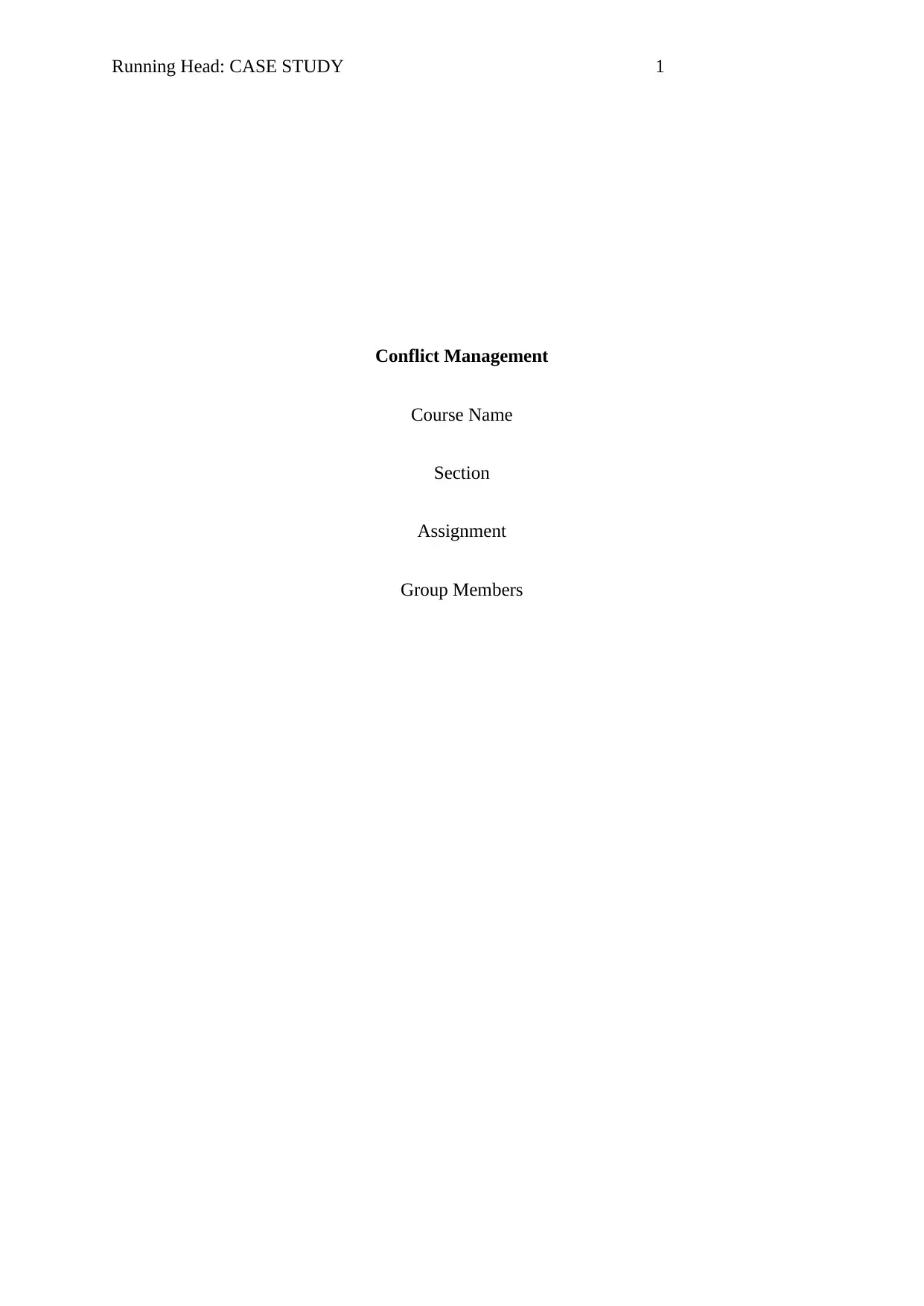
Running Head: CASE STUDY 1
Conflict Management
Course Name
Section
Assignment
Group Members
Conflict Management
Course Name
Section
Assignment
Group Members
Paraphrase This Document
Need a fresh take? Get an instant paraphrase of this document with our AI Paraphraser
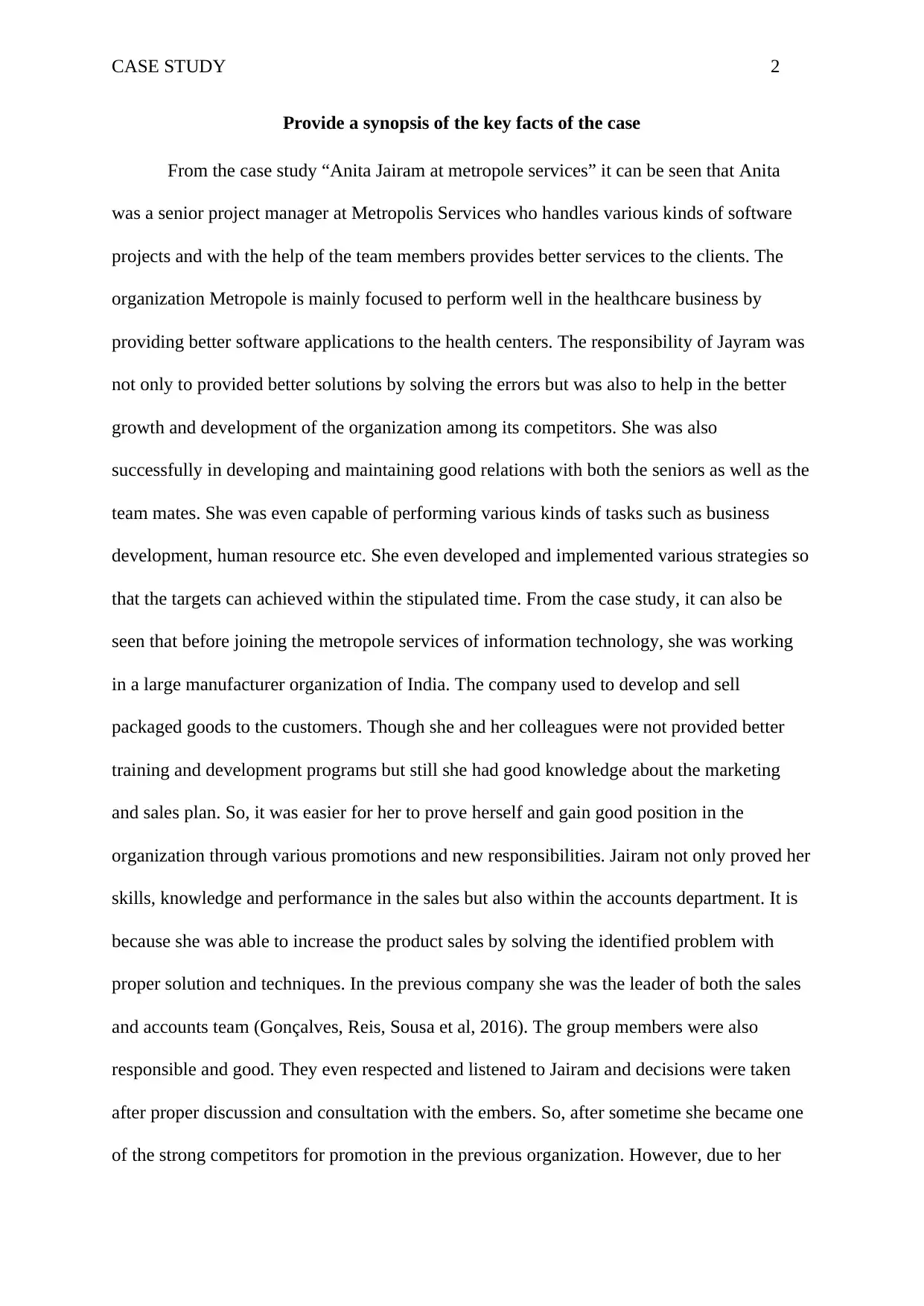
CASE STUDY 2
Provide a synopsis of the key facts of the case
From the case study “Anita Jairam at metropole services” it can be seen that Anita
was a senior project manager at Metropolis Services who handles various kinds of software
projects and with the help of the team members provides better services to the clients. The
organization Metropole is mainly focused to perform well in the healthcare business by
providing better software applications to the health centers. The responsibility of Jayram was
not only to provided better solutions by solving the errors but was also to help in the better
growth and development of the organization among its competitors. She was also
successfully in developing and maintaining good relations with both the seniors as well as the
team mates. She was even capable of performing various kinds of tasks such as business
development, human resource etc. She even developed and implemented various strategies so
that the targets can achieved within the stipulated time. From the case study, it can also be
seen that before joining the metropole services of information technology, she was working
in a large manufacturer organization of India. The company used to develop and sell
packaged goods to the customers. Though she and her colleagues were not provided better
training and development programs but still she had good knowledge about the marketing
and sales plan. So, it was easier for her to prove herself and gain good position in the
organization through various promotions and new responsibilities. Jairam not only proved her
skills, knowledge and performance in the sales but also within the accounts department. It is
because she was able to increase the product sales by solving the identified problem with
proper solution and techniques. In the previous company she was the leader of both the sales
and accounts team (Gonçalves, Reis, Sousa et al, 2016). The group members were also
responsible and good. They even respected and listened to Jairam and decisions were taken
after proper discussion and consultation with the embers. So, after sometime she became one
of the strong competitors for promotion in the previous organization. However, due to her
Provide a synopsis of the key facts of the case
From the case study “Anita Jairam at metropole services” it can be seen that Anita
was a senior project manager at Metropolis Services who handles various kinds of software
projects and with the help of the team members provides better services to the clients. The
organization Metropole is mainly focused to perform well in the healthcare business by
providing better software applications to the health centers. The responsibility of Jayram was
not only to provided better solutions by solving the errors but was also to help in the better
growth and development of the organization among its competitors. She was also
successfully in developing and maintaining good relations with both the seniors as well as the
team mates. She was even capable of performing various kinds of tasks such as business
development, human resource etc. She even developed and implemented various strategies so
that the targets can achieved within the stipulated time. From the case study, it can also be
seen that before joining the metropole services of information technology, she was working
in a large manufacturer organization of India. The company used to develop and sell
packaged goods to the customers. Though she and her colleagues were not provided better
training and development programs but still she had good knowledge about the marketing
and sales plan. So, it was easier for her to prove herself and gain good position in the
organization through various promotions and new responsibilities. Jairam not only proved her
skills, knowledge and performance in the sales but also within the accounts department. It is
because she was able to increase the product sales by solving the identified problem with
proper solution and techniques. In the previous company she was the leader of both the sales
and accounts team (Gonçalves, Reis, Sousa et al, 2016). The group members were also
responsible and good. They even respected and listened to Jairam and decisions were taken
after proper discussion and consultation with the embers. So, after sometime she became one
of the strong competitors for promotion in the previous organization. However, due to her
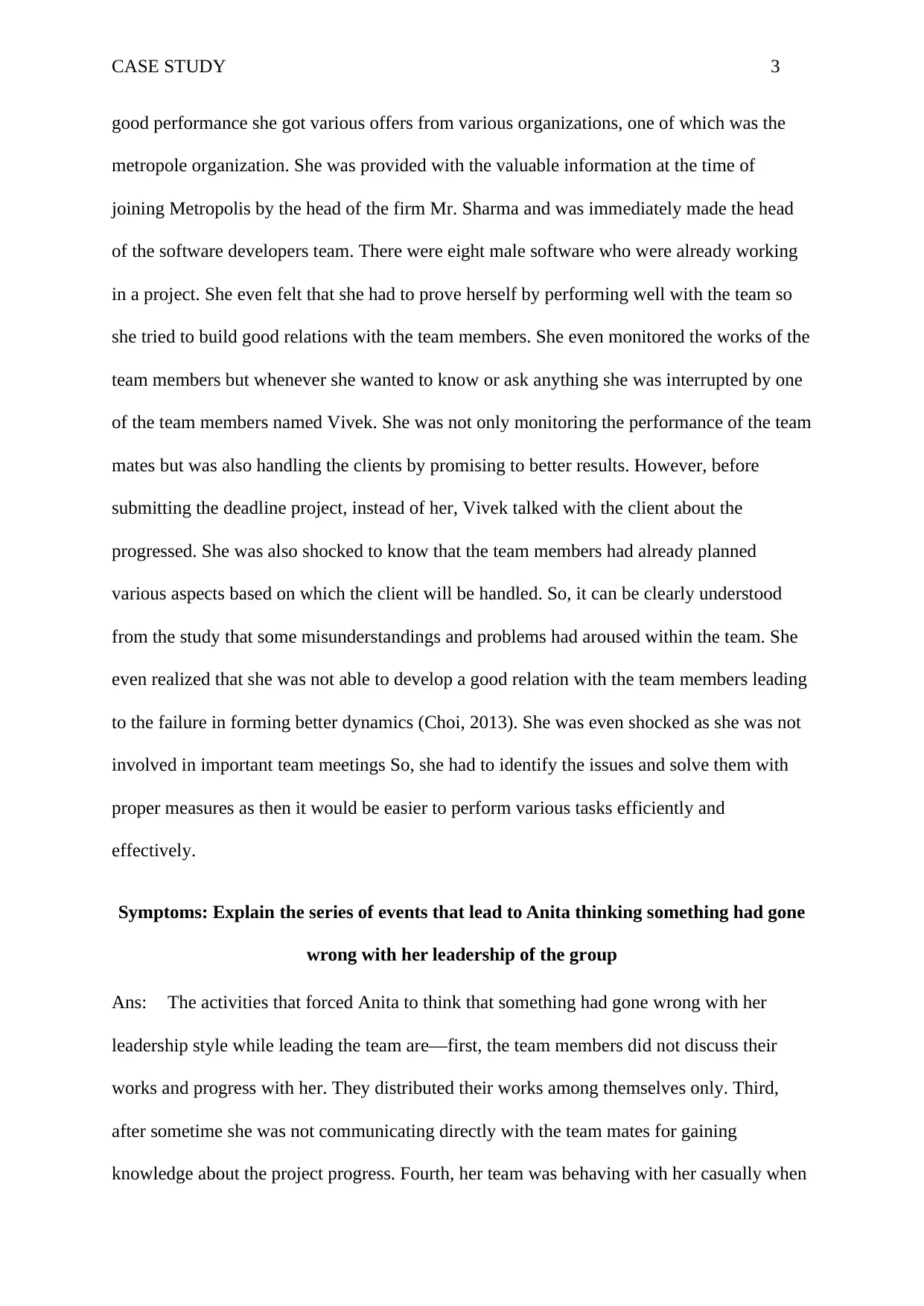
CASE STUDY 3
good performance she got various offers from various organizations, one of which was the
metropole organization. She was provided with the valuable information at the time of
joining Metropolis by the head of the firm Mr. Sharma and was immediately made the head
of the software developers team. There were eight male software who were already working
in a project. She even felt that she had to prove herself by performing well with the team so
she tried to build good relations with the team members. She even monitored the works of the
team members but whenever she wanted to know or ask anything she was interrupted by one
of the team members named Vivek. She was not only monitoring the performance of the team
mates but was also handling the clients by promising to better results. However, before
submitting the deadline project, instead of her, Vivek talked with the client about the
progressed. She was also shocked to know that the team members had already planned
various aspects based on which the client will be handled. So, it can be clearly understood
from the study that some misunderstandings and problems had aroused within the team. She
even realized that she was not able to develop a good relation with the team members leading
to the failure in forming better dynamics (Choi, 2013). She was even shocked as she was not
involved in important team meetings So, she had to identify the issues and solve them with
proper measures as then it would be easier to perform various tasks efficiently and
effectively.
Symptoms: Explain the series of events that lead to Anita thinking something had gone
wrong with her leadership of the group
Ans: The activities that forced Anita to think that something had gone wrong with her
leadership style while leading the team are—first, the team members did not discuss their
works and progress with her. They distributed their works among themselves only. Third,
after sometime she was not communicating directly with the team mates for gaining
knowledge about the project progress. Fourth, her team was behaving with her casually when
good performance she got various offers from various organizations, one of which was the
metropole organization. She was provided with the valuable information at the time of
joining Metropolis by the head of the firm Mr. Sharma and was immediately made the head
of the software developers team. There were eight male software who were already working
in a project. She even felt that she had to prove herself by performing well with the team so
she tried to build good relations with the team members. She even monitored the works of the
team members but whenever she wanted to know or ask anything she was interrupted by one
of the team members named Vivek. She was not only monitoring the performance of the team
mates but was also handling the clients by promising to better results. However, before
submitting the deadline project, instead of her, Vivek talked with the client about the
progressed. She was also shocked to know that the team members had already planned
various aspects based on which the client will be handled. So, it can be clearly understood
from the study that some misunderstandings and problems had aroused within the team. She
even realized that she was not able to develop a good relation with the team members leading
to the failure in forming better dynamics (Choi, 2013). She was even shocked as she was not
involved in important team meetings So, she had to identify the issues and solve them with
proper measures as then it would be easier to perform various tasks efficiently and
effectively.
Symptoms: Explain the series of events that lead to Anita thinking something had gone
wrong with her leadership of the group
Ans: The activities that forced Anita to think that something had gone wrong with her
leadership style while leading the team are—first, the team members did not discuss their
works and progress with her. They distributed their works among themselves only. Third,
after sometime she was not communicating directly with the team mates for gaining
knowledge about the project progress. Fourth, her team was behaving with her casually when
⊘ This is a preview!⊘
Do you want full access?
Subscribe today to unlock all pages.

Trusted by 1+ million students worldwide
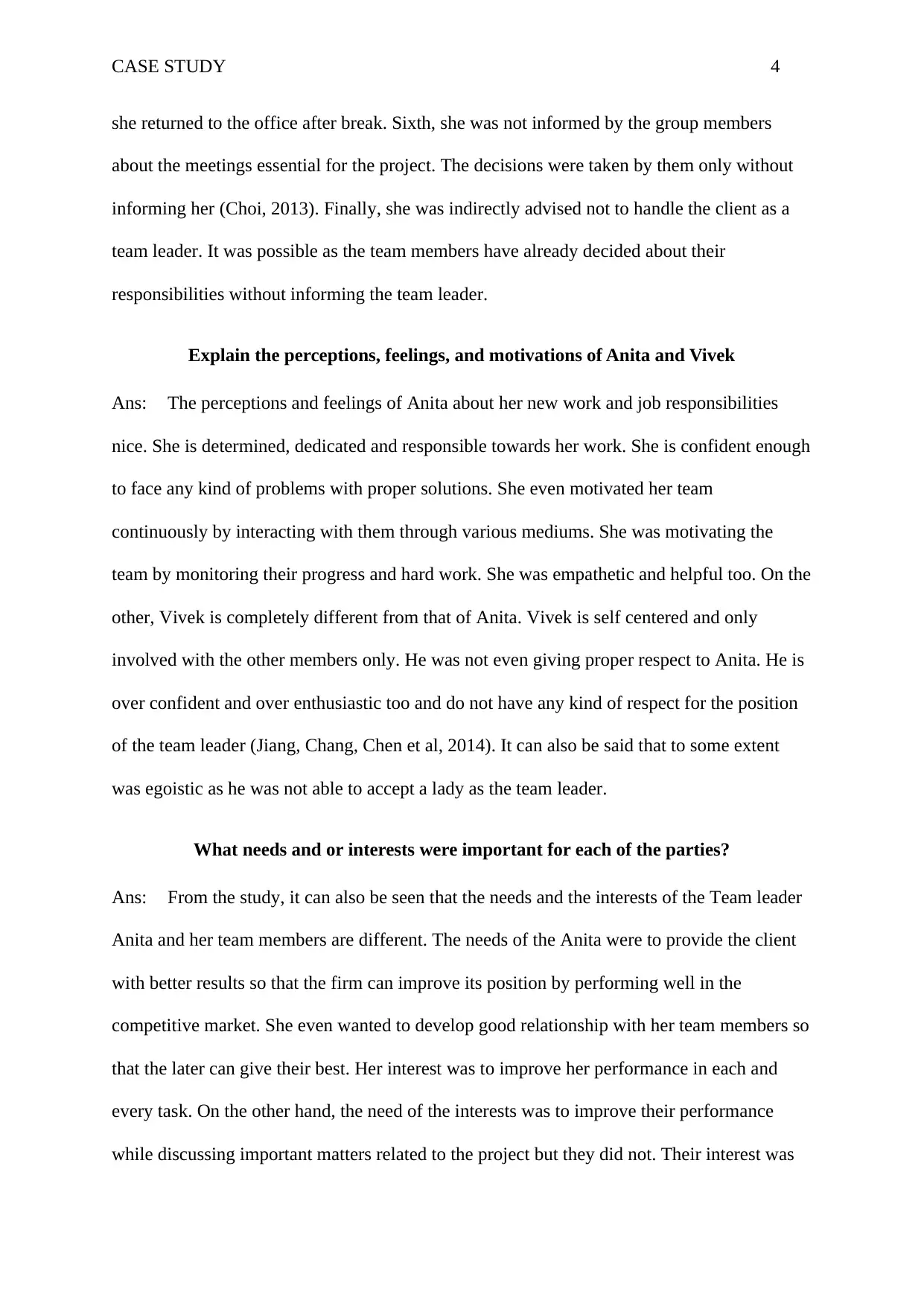
CASE STUDY 4
she returned to the office after break. Sixth, she was not informed by the group members
about the meetings essential for the project. The decisions were taken by them only without
informing her (Choi, 2013). Finally, she was indirectly advised not to handle the client as a
team leader. It was possible as the team members have already decided about their
responsibilities without informing the team leader.
Explain the perceptions, feelings, and motivations of Anita and Vivek
Ans: The perceptions and feelings of Anita about her new work and job responsibilities
nice. She is determined, dedicated and responsible towards her work. She is confident enough
to face any kind of problems with proper solutions. She even motivated her team
continuously by interacting with them through various mediums. She was motivating the
team by monitoring their progress and hard work. She was empathetic and helpful too. On the
other, Vivek is completely different from that of Anita. Vivek is self centered and only
involved with the other members only. He was not even giving proper respect to Anita. He is
over confident and over enthusiastic too and do not have any kind of respect for the position
of the team leader (Jiang, Chang, Chen et al, 2014). It can also be said that to some extent
was egoistic as he was not able to accept a lady as the team leader.
What needs and or interests were important for each of the parties?
Ans: From the study, it can also be seen that the needs and the interests of the Team leader
Anita and her team members are different. The needs of the Anita were to provide the client
with better results so that the firm can improve its position by performing well in the
competitive market. She even wanted to develop good relationship with her team members so
that the later can give their best. Her interest was to improve her performance in each and
every task. On the other hand, the need of the interests was to improve their performance
while discussing important matters related to the project but they did not. Their interest was
she returned to the office after break. Sixth, she was not informed by the group members
about the meetings essential for the project. The decisions were taken by them only without
informing her (Choi, 2013). Finally, she was indirectly advised not to handle the client as a
team leader. It was possible as the team members have already decided about their
responsibilities without informing the team leader.
Explain the perceptions, feelings, and motivations of Anita and Vivek
Ans: The perceptions and feelings of Anita about her new work and job responsibilities
nice. She is determined, dedicated and responsible towards her work. She is confident enough
to face any kind of problems with proper solutions. She even motivated her team
continuously by interacting with them through various mediums. She was motivating the
team by monitoring their progress and hard work. She was empathetic and helpful too. On the
other, Vivek is completely different from that of Anita. Vivek is self centered and only
involved with the other members only. He was not even giving proper respect to Anita. He is
over confident and over enthusiastic too and do not have any kind of respect for the position
of the team leader (Jiang, Chang, Chen et al, 2014). It can also be said that to some extent
was egoistic as he was not able to accept a lady as the team leader.
What needs and or interests were important for each of the parties?
Ans: From the study, it can also be seen that the needs and the interests of the Team leader
Anita and her team members are different. The needs of the Anita were to provide the client
with better results so that the firm can improve its position by performing well in the
competitive market. She even wanted to develop good relationship with her team members so
that the later can give their best. Her interest was to improve her performance in each and
every task. On the other hand, the need of the interests was to improve their performance
while discussing important matters related to the project but they did not. Their interest was
Paraphrase This Document
Need a fresh take? Get an instant paraphrase of this document with our AI Paraphraser
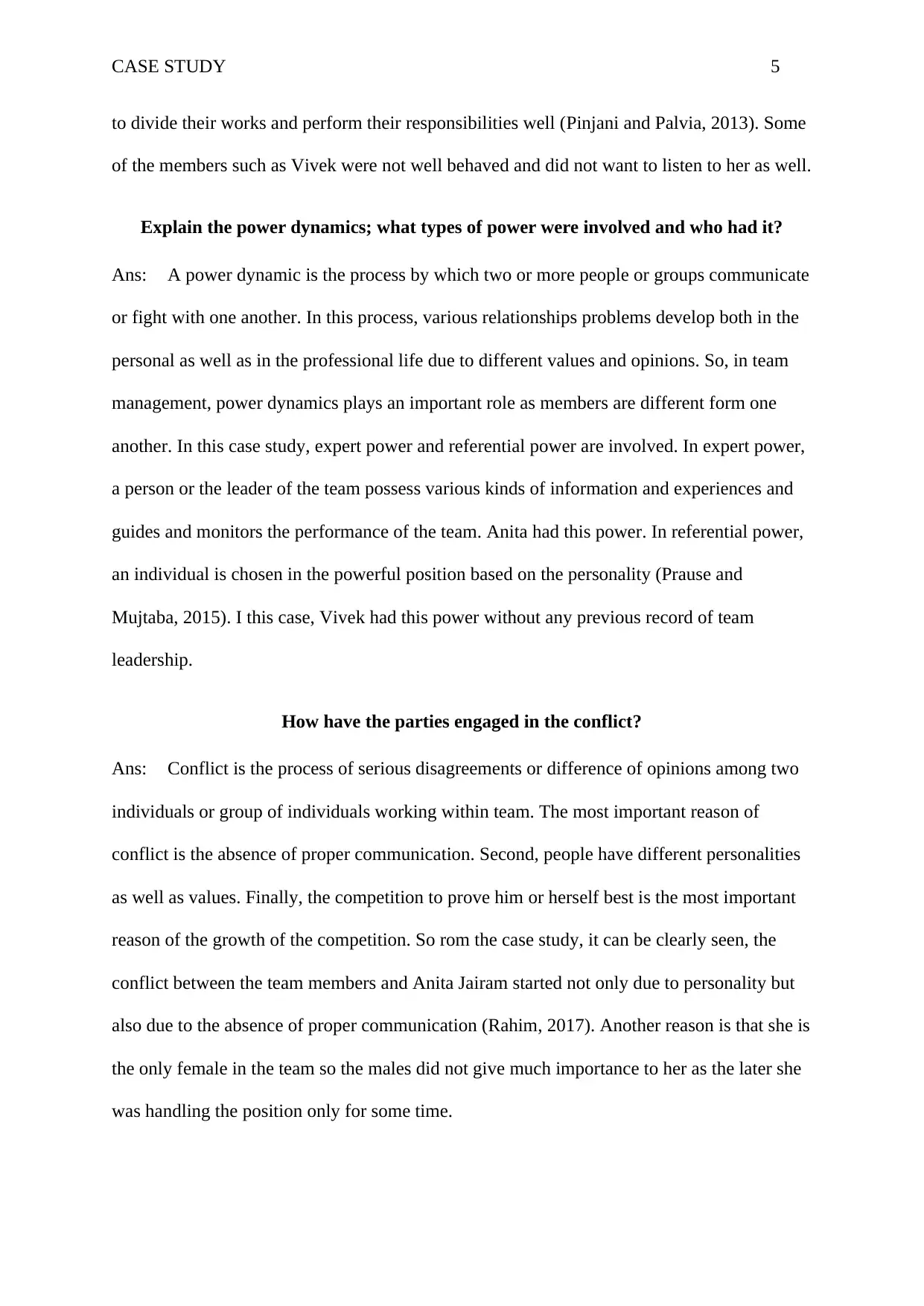
CASE STUDY 5
to divide their works and perform their responsibilities well (Pinjani and Palvia, 2013). Some
of the members such as Vivek were not well behaved and did not want to listen to her as well.
Explain the power dynamics; what types of power were involved and who had it?
Ans: A power dynamic is the process by which two or more people or groups communicate
or fight with one another. In this process, various relationships problems develop both in the
personal as well as in the professional life due to different values and opinions. So, in team
management, power dynamics plays an important role as members are different form one
another. In this case study, expert power and referential power are involved. In expert power,
a person or the leader of the team possess various kinds of information and experiences and
guides and monitors the performance of the team. Anita had this power. In referential power,
an individual is chosen in the powerful position based on the personality (Prause and
Mujtaba, 2015). I this case, Vivek had this power without any previous record of team
leadership.
How have the parties engaged in the conflict?
Ans: Conflict is the process of serious disagreements or difference of opinions among two
individuals or group of individuals working within team. The most important reason of
conflict is the absence of proper communication. Second, people have different personalities
as well as values. Finally, the competition to prove him or herself best is the most important
reason of the growth of the competition. So rom the case study, it can be clearly seen, the
conflict between the team members and Anita Jairam started not only due to personality but
also due to the absence of proper communication (Rahim, 2017). Another reason is that she is
the only female in the team so the males did not give much importance to her as the later she
was handling the position only for some time.
to divide their works and perform their responsibilities well (Pinjani and Palvia, 2013). Some
of the members such as Vivek were not well behaved and did not want to listen to her as well.
Explain the power dynamics; what types of power were involved and who had it?
Ans: A power dynamic is the process by which two or more people or groups communicate
or fight with one another. In this process, various relationships problems develop both in the
personal as well as in the professional life due to different values and opinions. So, in team
management, power dynamics plays an important role as members are different form one
another. In this case study, expert power and referential power are involved. In expert power,
a person or the leader of the team possess various kinds of information and experiences and
guides and monitors the performance of the team. Anita had this power. In referential power,
an individual is chosen in the powerful position based on the personality (Prause and
Mujtaba, 2015). I this case, Vivek had this power without any previous record of team
leadership.
How have the parties engaged in the conflict?
Ans: Conflict is the process of serious disagreements or difference of opinions among two
individuals or group of individuals working within team. The most important reason of
conflict is the absence of proper communication. Second, people have different personalities
as well as values. Finally, the competition to prove him or herself best is the most important
reason of the growth of the competition. So rom the case study, it can be clearly seen, the
conflict between the team members and Anita Jairam started not only due to personality but
also due to the absence of proper communication (Rahim, 2017). Another reason is that she is
the only female in the team so the males did not give much importance to her as the later she
was handling the position only for some time.
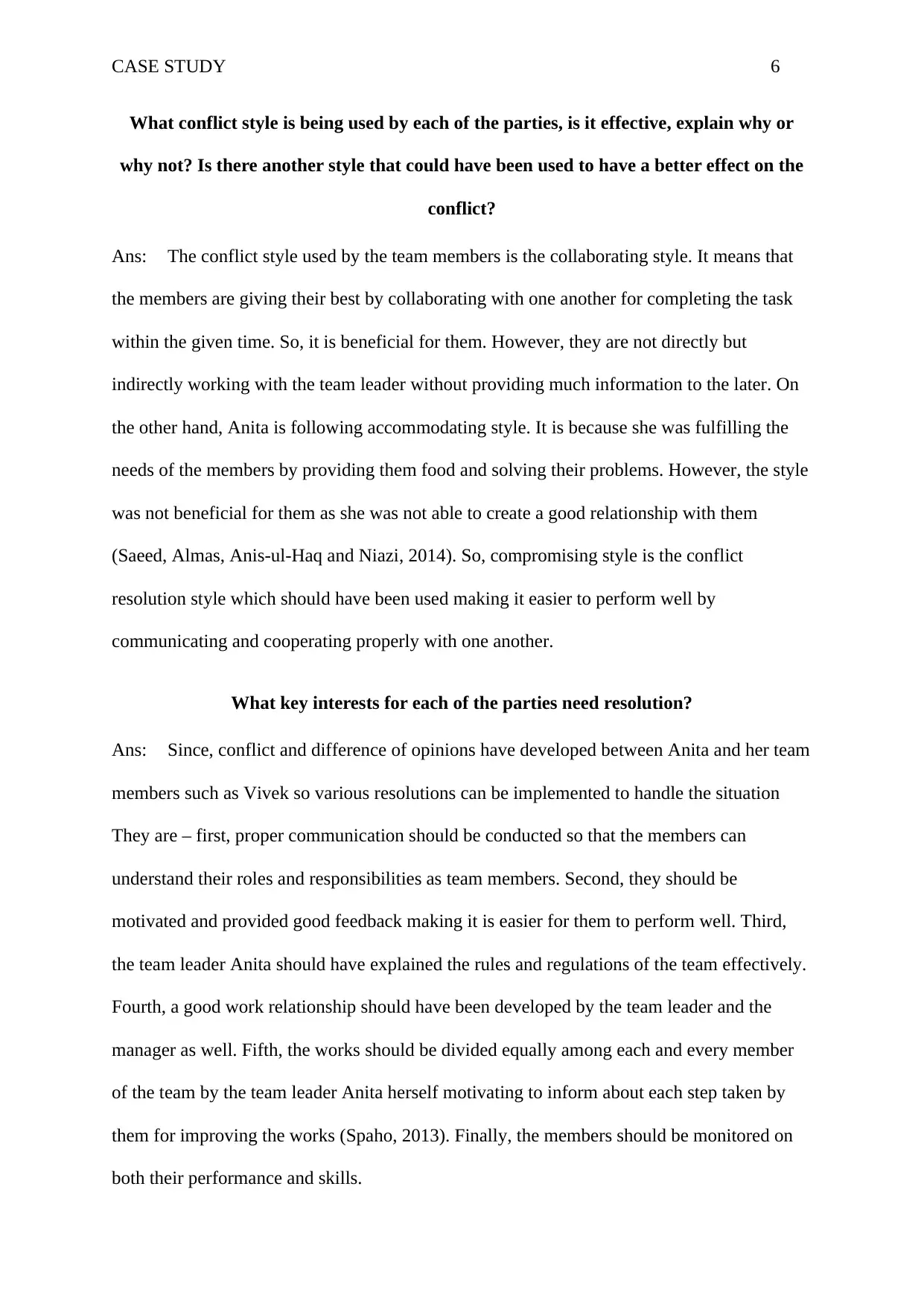
CASE STUDY 6
What conflict style is being used by each of the parties, is it effective, explain why or
why not? Is there another style that could have been used to have a better effect on the
conflict?
Ans: The conflict style used by the team members is the collaborating style. It means that
the members are giving their best by collaborating with one another for completing the task
within the given time. So, it is beneficial for them. However, they are not directly but
indirectly working with the team leader without providing much information to the later. On
the other hand, Anita is following accommodating style. It is because she was fulfilling the
needs of the members by providing them food and solving their problems. However, the style
was not beneficial for them as she was not able to create a good relationship with them
(Saeed, Almas, Anis-ul-Haq and Niazi, 2014). So, compromising style is the conflict
resolution style which should have been used making it easier to perform well by
communicating and cooperating properly with one another.
What key interests for each of the parties need resolution?
Ans: Since, conflict and difference of opinions have developed between Anita and her team
members such as Vivek so various resolutions can be implemented to handle the situation
They are – first, proper communication should be conducted so that the members can
understand their roles and responsibilities as team members. Second, they should be
motivated and provided good feedback making it is easier for them to perform well. Third,
the team leader Anita should have explained the rules and regulations of the team effectively.
Fourth, a good work relationship should have been developed by the team leader and the
manager as well. Fifth, the works should be divided equally among each and every member
of the team by the team leader Anita herself motivating to inform about each step taken by
them for improving the works (Spaho, 2013). Finally, the members should be monitored on
both their performance and skills.
What conflict style is being used by each of the parties, is it effective, explain why or
why not? Is there another style that could have been used to have a better effect on the
conflict?
Ans: The conflict style used by the team members is the collaborating style. It means that
the members are giving their best by collaborating with one another for completing the task
within the given time. So, it is beneficial for them. However, they are not directly but
indirectly working with the team leader without providing much information to the later. On
the other hand, Anita is following accommodating style. It is because she was fulfilling the
needs of the members by providing them food and solving their problems. However, the style
was not beneficial for them as she was not able to create a good relationship with them
(Saeed, Almas, Anis-ul-Haq and Niazi, 2014). So, compromising style is the conflict
resolution style which should have been used making it easier to perform well by
communicating and cooperating properly with one another.
What key interests for each of the parties need resolution?
Ans: Since, conflict and difference of opinions have developed between Anita and her team
members such as Vivek so various resolutions can be implemented to handle the situation
They are – first, proper communication should be conducted so that the members can
understand their roles and responsibilities as team members. Second, they should be
motivated and provided good feedback making it is easier for them to perform well. Third,
the team leader Anita should have explained the rules and regulations of the team effectively.
Fourth, a good work relationship should have been developed by the team leader and the
manager as well. Fifth, the works should be divided equally among each and every member
of the team by the team leader Anita herself motivating to inform about each step taken by
them for improving the works (Spaho, 2013). Finally, the members should be monitored on
both their performance and skills.
⊘ This is a preview!⊘
Do you want full access?
Subscribe today to unlock all pages.

Trusted by 1+ million students worldwide
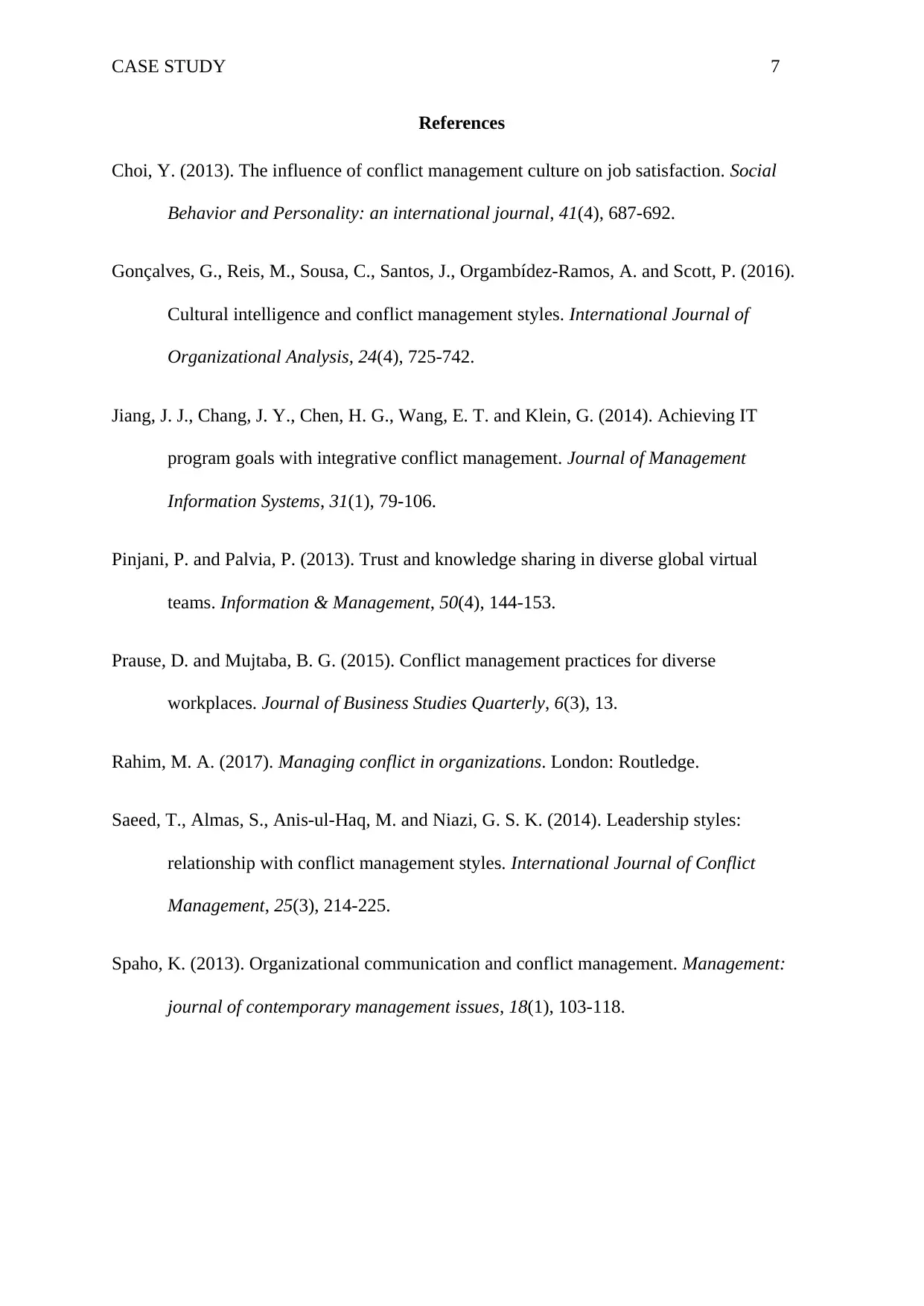
CASE STUDY 7
References
Choi, Y. (2013). The influence of conflict management culture on job satisfaction. Social
Behavior and Personality: an international journal, 41(4), 687-692.
Gonçalves, G., Reis, M., Sousa, C., Santos, J., Orgambídez-Ramos, A. and Scott, P. (2016).
Cultural intelligence and conflict management styles. International Journal of
Organizational Analysis, 24(4), 725-742.
Jiang, J. J., Chang, J. Y., Chen, H. G., Wang, E. T. and Klein, G. (2014). Achieving IT
program goals with integrative conflict management. Journal of Management
Information Systems, 31(1), 79-106.
Pinjani, P. and Palvia, P. (2013). Trust and knowledge sharing in diverse global virtual
teams. Information & Management, 50(4), 144-153.
Prause, D. and Mujtaba, B. G. (2015). Conflict management practices for diverse
workplaces. Journal of Business Studies Quarterly, 6(3), 13.
Rahim, M. A. (2017). Managing conflict in organizations. London: Routledge.
Saeed, T., Almas, S., Anis-ul-Haq, M. and Niazi, G. S. K. (2014). Leadership styles:
relationship with conflict management styles. International Journal of Conflict
Management, 25(3), 214-225.
Spaho, K. (2013). Organizational communication and conflict management. Management:
journal of contemporary management issues, 18(1), 103-118.
References
Choi, Y. (2013). The influence of conflict management culture on job satisfaction. Social
Behavior and Personality: an international journal, 41(4), 687-692.
Gonçalves, G., Reis, M., Sousa, C., Santos, J., Orgambídez-Ramos, A. and Scott, P. (2016).
Cultural intelligence and conflict management styles. International Journal of
Organizational Analysis, 24(4), 725-742.
Jiang, J. J., Chang, J. Y., Chen, H. G., Wang, E. T. and Klein, G. (2014). Achieving IT
program goals with integrative conflict management. Journal of Management
Information Systems, 31(1), 79-106.
Pinjani, P. and Palvia, P. (2013). Trust and knowledge sharing in diverse global virtual
teams. Information & Management, 50(4), 144-153.
Prause, D. and Mujtaba, B. G. (2015). Conflict management practices for diverse
workplaces. Journal of Business Studies Quarterly, 6(3), 13.
Rahim, M. A. (2017). Managing conflict in organizations. London: Routledge.
Saeed, T., Almas, S., Anis-ul-Haq, M. and Niazi, G. S. K. (2014). Leadership styles:
relationship with conflict management styles. International Journal of Conflict
Management, 25(3), 214-225.
Spaho, K. (2013). Organizational communication and conflict management. Management:
journal of contemporary management issues, 18(1), 103-118.
1 out of 7
Related Documents
Your All-in-One AI-Powered Toolkit for Academic Success.
+13062052269
info@desklib.com
Available 24*7 on WhatsApp / Email
![[object Object]](/_next/static/media/star-bottom.7253800d.svg)
Unlock your academic potential
Copyright © 2020–2025 A2Z Services. All Rights Reserved. Developed and managed by ZUCOL.





